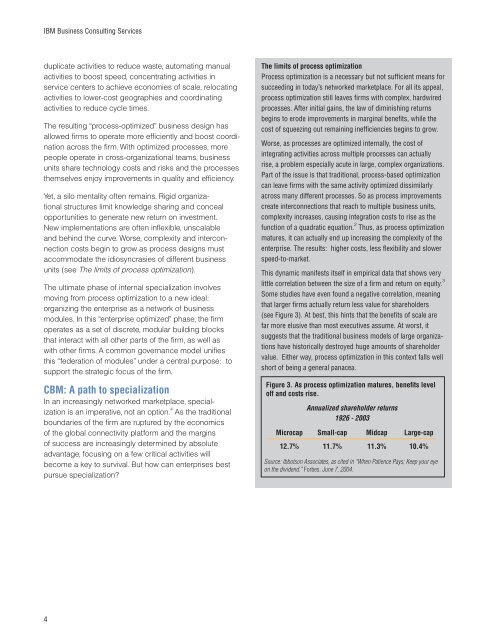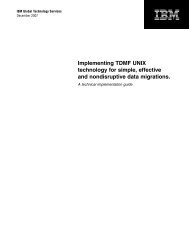Component business models - IBM
Component business models - IBM
Component business models - IBM
You also want an ePaper? Increase the reach of your titles
YUMPU automatically turns print PDFs into web optimized ePapers that Google loves.
<strong>IBM</strong> Business Consulting Services<br />
duplicate activities to reduce waste, automating manual<br />
activities to boost speed, concentrating activities in<br />
service centers to achieve economies of scale, relocating<br />
activities to lower-cost geographies and coordinating<br />
activities to reduce cycle times.<br />
The resulting “process-optimized” <strong>business</strong> design has<br />
allowed firms to operate more efficiently and boost coordination<br />
across the firm. With optimized processes, more<br />
people operate in cross-organizational teams, <strong>business</strong><br />
units share technology costs and risks and the processes<br />
themselves enjoy improvements in quality and efficiency.<br />
Yet, a silo mentality often remains. Rigid organizational<br />
structures limit knowledge sharing and conceal<br />
opportunities to generate new return on investment.<br />
New implementations are often inflexible, unscalable<br />
and behind the curve. Worse, complexity and interconnection<br />
costs begin to grow as process designs must<br />
accommodate the idiosyncrasies of different <strong>business</strong><br />
units (see The limits of process optimization).<br />
The ultimate phase of internal specialization involves<br />
moving from process optimization to a new ideal:<br />
organizing the enterprise as a network of <strong>business</strong><br />
modules. In this “enterprise optimized” phase, the firm<br />
operates as a set of discrete, modular building blocks<br />
that interact with all other parts of the firm, as well as<br />
with other firms. A common governance model unifies<br />
this “federation of modules” under a central purpose: to<br />
support the strategic focus of the firm.<br />
CBM: A path to specialization<br />
In an increasingly networked marketplace, specialization<br />
is an imperative, not an option. 4 As the traditional<br />
boundaries of the firm are ruptured by the economics<br />
of the global connectivity platform and the margins<br />
of success are increasingly determined by absolute<br />
advantage, focusing on a few critical activities will<br />
become a key to survival. But how can enterprises best<br />
pursue specialization?<br />
4<br />
The limits of process optimization<br />
Process optimization is a necessary but not sufficient means for<br />
succeeding in today’s networked marketplace. For all its appeal,<br />
process optimization still leaves firms with complex, hardwired<br />
processes. After initial gains, the law of diminishing returns<br />
begins to erode improvements in marginal benefits, while the<br />
cost of squeezing out remaining inefficiencies begins to grow.<br />
Worse, as processes are optimized internally, the cost of<br />
integrating activities across multiple processes can actually<br />
rise, a problem especially acute in large, complex organizations.<br />
Part of the issue is that traditional, process-based optimization<br />
can leave firms with the same activity optimized dissimilarly<br />
across many different processes. So as process improvements<br />
create interconnections that reach to multiple <strong>business</strong> units,<br />
complexity increases, causing integration costs to rise as the<br />
function of a quadratic equation. 2 Thus, as process optimization<br />
matures, it can actually end up increasing the complexity of the<br />
enterprise. The results: higher costs, less flexibility and slower<br />
speed-to-market.<br />
This dynamic manifests itself in empirical data that shows very<br />
little correlation between the size of a firm and return on equity. 3<br />
Some studies have even found a negative correlation, meaning<br />
that larger firms actually return less value for shareholders<br />
(see Figure 3). At best, this hints that the benefits of scale are<br />
far more elusive than most executives assume. At worst, it<br />
suggests that the traditional <strong>business</strong> <strong>models</strong> of large organizations<br />
have historically destroyed huge amounts of shareholder<br />
value. Either way, process optimization in this context falls well<br />
short of being a general panacea.<br />
Figure 3. As process optimization matures, benefi ts level<br />
off and costs rise.<br />
Annualized shareholder returns<br />
1926 - 2003<br />
Microcap Small-cap Midcap Large-cap<br />
12.7% 11.7% 11.3% 10.4%<br />
Source: Ibbotson Associates, as cited in “When Patience Pays; Keep your eye<br />
on the dividend.” Forbes. June 7, 2004.

















